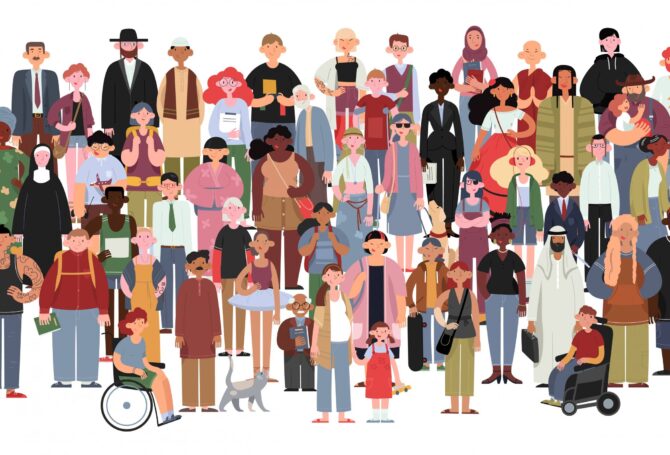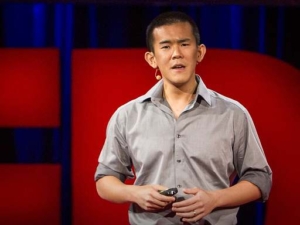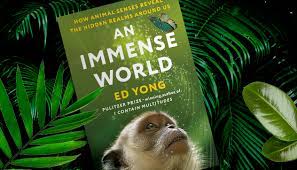
Limits of Human Perception Blind View of Diverse World of Adaptation
Diversity programs have been engulfed by conservative political claims of “wokeness” despite program goals to recognize people from many backgrounds with many different experiences and many different perspectives. A lesson from the animal world may be instructive.
There is a world of sound, color and sensitivity surrounding us that exists beyond human sensory comprehension. Animals have the ability to hear, see and sense what we can’t. Plants feel vibrations we don’t. Human perception of this diversity is inhibited by human sensory limitations. Disinterest or disbelief doesn’t negate the reality of diversity.
 Award-winning science journalist Ed Yong’s newly published book titled An Immense World describes how different species perceive the world in radically different and unique ways that shape their adaptation.
Award-winning science journalist Ed Yong’s newly published book titled An Immense World describes how different species perceive the world in radically different and unique ways that shape their adaptation.
He makes his point with a thought experiment involving an elephant, rattlesnake, bumblebee, dog, mouse and bat. The elephant produces low-frequency sounds other animals can’t hear. The mouse hears the high-frequency calls by the bat. The rattlesnake detects infrared radiation emitted by the mouse. The bee sees ultraviolet colors in flowers. The dog’s color palette is limited but it smells scents that only the elephant could smell, too.
In an interview for the radio show On Point, Yong said imagining how a bat views the world can inform humans on how they may imperfectly picture a friend, colleague or adversary.
 Bats use sonar for direction as well as perception, according to Yong. “By recording the bat’s calls you can actually get a reasonable glimpse into the bat’s intent. You can get as close as possible to reading its mind, simply by listening to the sounds it’s producing to sense the world.” If humans paid more attention, they might discern more about what others are thinking, feeling and planning.
Bats use sonar for direction as well as perception, according to Yong. “By recording the bat’s calls you can actually get a reasonable glimpse into the bat’s intent. You can get as close as possible to reading its mind, simply by listening to the sounds it’s producing to sense the world.” If humans paid more attention, they might discern more about what others are thinking, feeling and planning.
There are animals and plants on earth that predate human evolution. Their adaptations should be a lesson on how to appreciate diversity. For example, sloths have survived in rainforests by instinctively moving slowly to conserve energy and avoid detection. Moving slowly is not a survival skill that would come naturally to humans. We call it slothful.
Hubris makes humans believe they dominate the world. While humans may dominate territory and animals, there are domains humans don’t perceive or understand. Yong described how sea turtles respond to magnetic signatures to navigate the Atlantic Ocean. “It’s like the animal has a magnetic map of the planet and a compass in its head that allows it to use that map.” Yong says this seemingly innate skill remains a puzzle to scientists. “We don’t even know what the sense organ is.”
 “I think a lot of the ways in which people have thought about their place in the natural world has been one of lordship and dominion for many centuries,” Yong said. “I think understanding these sensory worlds knocks us down a peg or two. It tells us that our experience is just one of many experiences.” On Point host Meghna Chakrabarti called Yong’s insight “inspirational humility”.
“I think a lot of the ways in which people have thought about their place in the natural world has been one of lordship and dominion for many centuries,” Yong said. “I think understanding these sensory worlds knocks us down a peg or two. It tells us that our experience is just one of many experiences.” On Point host Meghna Chakrabarti called Yong’s insight “inspirational humility”.
Diversity, Equity and Inclusion
Hidden realms of animal and plant life should serve as reminders that humans also embody diversity, which can be unrecognized, unappreciated and unaccepted. Diversity, Equity and Inclusion programs are intended to promote work environments that celebrate diversity and achieve equity through inclusion.
As Yong’s writing reveals, diversity is more than a social policy, it is a survival skill. Maintaining diversity is the rationale for protecting endangered species and preserving natural areas. It is the reason to accommodate apex predators that play a role in maintaining ecosystem equilibrium and vital food chains.
Diversity isn’t social hokum but instead a natural reality of adaptation, in animals, plants and humans. Being different is inevitable, not bad. More perspectives can be better than a narrow one. Diversity is actually healthy, not divisive.
Inspirational Humility
Accepting differences requires, as Yong suggests, the humility to admit humans may be smart but don’t know everything. In relative terms, we may only “see” a fraction of what’s going on around us and how it affects other people, animals, plants, water, air and the planet itself. The same “blindness” can be true with the diversity in people around us.
 Ernest Hemingway summed up humility this way. “There is nothing noble in being superior to your fellow man; true nobility is being superior to your former self.”
Ernest Hemingway summed up humility this way. “There is nothing noble in being superior to your fellow man; true nobility is being superior to your former self.”
Contrary to critics, appreciating diversity is much more than political correctness or a surrender to woke politics. Human capability is enhanced, not restrained, by acknowledging differences and exploring them with an open mind. Understanding a wider context can inform human interactions, enhance relationships and improve working conditions. Being open to diversity can broaden a person’s range of friendships, business relationships, books to read and subjects to explore.
Writing for Forbes, Bernard Tynes, director of marketing and data analytics for Penn Community Bank, wrote, “I have found diversity brings together people from different backgrounds, showcases a variety of perspectives and leads to innovation and creativity. When you bring people together from all walks of life – different genders, backgrounds and races – it’s amazing what we can accomplish.”
Every kind of animal, including humans, is enclosed within its own unique sensory bubble, perceiving only a tiny sliver of our immense world.
Homage to Other Living Things
If you have trouble coping with human diversity, take a lesson from animal and plant life around you.
 In his latest book, Yong says, “The Earth teems with sights and textures, sounds and vibrations, smells and tastes, electric and magnetic fields. But every kind of animal, including humans, is enclosed within its own unique sensory bubble, perceiving but a tiny sliver of our immense world. “
In his latest book, Yong says, “The Earth teems with sights and textures, sounds and vibrations, smells and tastes, electric and magnetic fields. But every kind of animal, including humans, is enclosed within its own unique sensory bubble, perceiving but a tiny sliver of our immense world. “
For humans, that bubble isn’t mandatory. We have the brains, opportunities and tools to escape our bubbles and expand our human perception of unseen and unheard realities. We can see other parts of the world through travel. We can be curious about animal and plant life around us. We can read books that inform us about everything from atoms to the vastness of space. We can befriend people of different races and backgrounds. We can applaud diversity.
One critic praised Yong’s book: “A powerful and immersive deep dive into the perceptual lives of other organisms– and a persuasive case for more empathy and understanding of the complexity, sophistication and sheer riotous joy of the nonhuman world.” The critic could have added that Yong’s insight is an opening for greater empathy and understanding by the human world.




